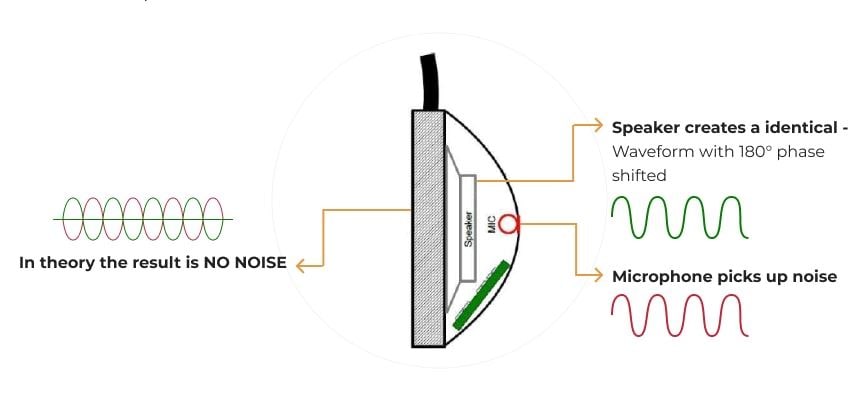Active Noise Cancellation (ANC) is a feature of mid-to-high-end wireless headphones that block outside noise by performing what’s called “signal processing” to block outside noise. To simply put, the ANC function allows most of the distracting noise to be filtered out.
Table of Contents
How does active noise cancelling work?
Active noise cancelling is an array of microphones placed around an earpiece or in-ear headphones and works through a concept known as phase cancellation. The first step is to use these microphones to determine what the listener is hearing.

When the microphones capture this sound, the digital signal processing hardware and software inside the headset starts working. This is where things get complicated. You’ve probably heard the term “sound wave” before.
Sound is a series of vibrations in the air. The peak of one waveform occurs simultaneously with a peak in the opposite direction of the other waveform, so they effectively cancel each other out. This is the principle of operation in headphones.
Passive insulation: simple concept, complex implementation
Isolating passively, without any active mechanism, is not very complicated… at least in theory. It suffices for this to use a resistant, thick, preferably dense material that is placed between the source of the noise and the listener to isolate the latter. And if that isn’t enough, just add more. This is the function of the foam ear cups of a closed headphone; in addition to comfort.
But there you have it: the more insulation you want, the more insulation you have to add; or else alternate layers of different materials according to skillful mixtures to design an insulation sandwich so each thickness plays a different role. And the thickness continues to grow.
For our recording studio or our concert hall at the beginning of the article, no problem, there is room to place the insulation! On a headset on the other hand, the space is confined, and the final product must not be too big, too heavy, too ugly.
As a result, in passive insulation, and despite recent progress since the explosion of nomadic headphones (notably shape memory foam, which provides better sealing of the auricle), it is rare to exceed 20 dB of mitigation.
In-ear headphones have brought a considerable gain to passive isolation: directly housed in the auditory canal, the obstruction is easier to obtain and more effective.
As a result, with dual flanges or foams, it is possible to exceed 26 dB of attenuation. This is already four times better than the attenuation of headphones!
But to make further progress in this quest for absolute silence, it’s difficult to go further without transforming the nomadic headset into a worksite noise-cancelling headset. The use of active technology becomes mandatory.
ANC in Space Industry
Second half of the 20th century, in the middle of the Cold War, space conquest became a priority for the USA. After the success of the Apollo program, NASA embarked on the development of a space shuttle allowing regular trips and interventions in space.

As the project is about to come to an end, an unexpected but major problem appears: the noise generated inside the cockpit is absolutely enormous. Nothing helps, not even the best noise canceling headphones of the time. If the crew were to suffer from the noise pollution of the machine, they would quickly lose their ears. Impossible to continue under these conditions.
A brand already well established in the professional audio sector, Bose, will then work to develop noise-cancelling headphones, oriented towards active technology. And to top it off, the principle is not very complicated to implement and fits in a small volume.
ANC Technology: Today and tomorrow
The current generation of active noise-canceling headphones far outperform their ancestors. In addition to the computing power and the increased number of microphones, the manufacturers have looked into the sensitivity of the human ear. Indeed, the latter does not react in the same way to different sounds, depending on whether they are more or less serious or acute. The new algorithms focus on the most troublesome.
The Audio Technica ATH-ANC9 is the first headset to introduce different noise reduction profiles depending on the context of use
Audio-Technica recently introduced a profile system: depending on whether you want to be quiet in an already peaceful place, in the middle of the street or in the office – each environment has a different noise profile – the headphones adopt different masks and adapted to the place of listening.
Significant progress that allows active noise reduction to be supported even by users up to now disturbed by the physical sensation that these headphones produce. And tomorrow ?
In the future, it will no longer be headphones that will insulate, but rooms or entire places. In fact, the management of interactions and interferences between waves is at the heart of a large number of ongoing research on the spatialized audio broadcasting systems of tomorrow.
Thus at Ircam (Institute for Acoustic/Music Research and Coordination), WFS (WaveField Synthesis, or Wave Field Synthesis) uses several hundred speakers aligned and controlled by computers to reproduce a source virtual sound within a room. And it is possible to position this “false” source anywhere in the room! A listener could then believe that his seat neighbor has just spoken to him, while the sound is coming from the speaker rails.
If it is possible to simulate a virtual source positioned anywhere in a room, it is then also possible to “target” a particular listener, or on the contrary to silence an entire area.
Thus, no doubt, later, it will be possible, in a library for example, to cut oneself off from the surrounding sounds to read a book in peace, while an office neighbor located a few tens of centimeters away will be broadcasting in a sound “halo” background music of your choice.
Active noise reduction In the cars
It doesn’t seem obvious at first glance, but active noise reduction has already made its way into cars!
Nothing out of the ordinary there: most of the nuisance in the cabin comes from engine noise and rolling noise. As a result, the active noise reduction specialists took over their processing circuits, connected them to microphones located in the passenger compartment, as well as to the on-board computer which transmits the engine speed in real time. The DSPs (processors dedicated to specific calculations) are responsible for emitting an opposite signal in the passenger compartment.
So in the results, the engine is less noisy, the friction of the air and the tires also, but the blows of horn are not masked as expected…




